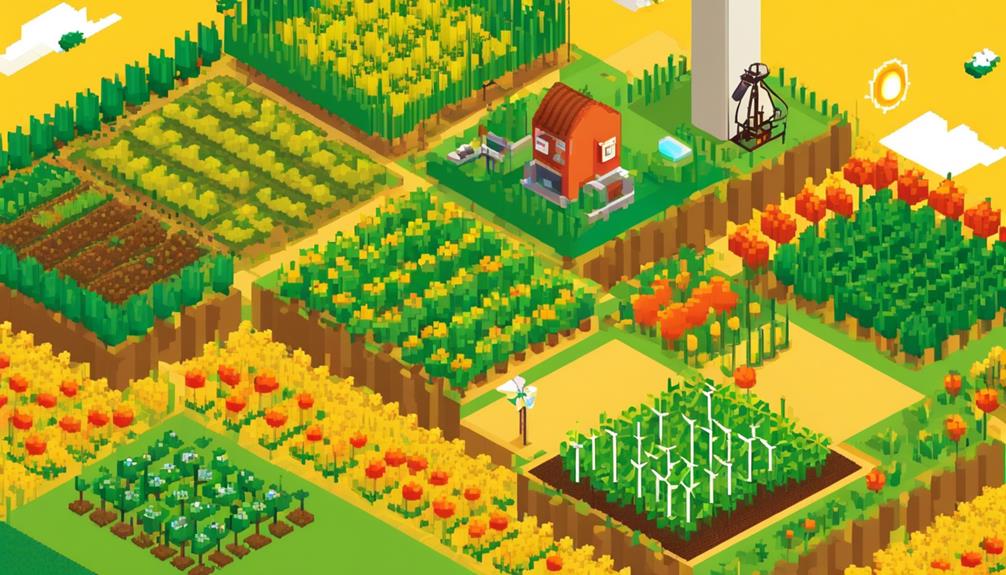As the global population continues to grow, the demand for food production is increasing at an unprecedented rate. In order to meet this demand, the agriculture industry is turning to IoT solutions to optimize operations and improve productivity.
One crucial aspect of implementing IoT in agriculture is the use of hardware solutions, which encompass a diverse range of devices and sensors. These hardware solutions play a vital role in enabling farmers and agricultural businesses to monitor and control various aspects of their operations, from crop management to livestock tracking.
In this discussion, we will explore the different types of hardware solutions available in IoT agriculture and their impact on enhancing efficiency, reducing costs, and ensuring sustainable food production.
Key Takeaways
- Sensors and monitoring systems play a crucial role in collecting environmental and machine metrics in agriculture.
- IoT technology enables automated irrigation and water management, optimizing water usage based on real-time data.
- Livestock tracking and management are enhanced through IoT sensors, allowing for monitoring of animal health and grazing behavior.
- Animal health monitoring and grazing behavior analysis contribute to early disease detection and optimal livestock management practices.
Sensors and Monitoring Systems
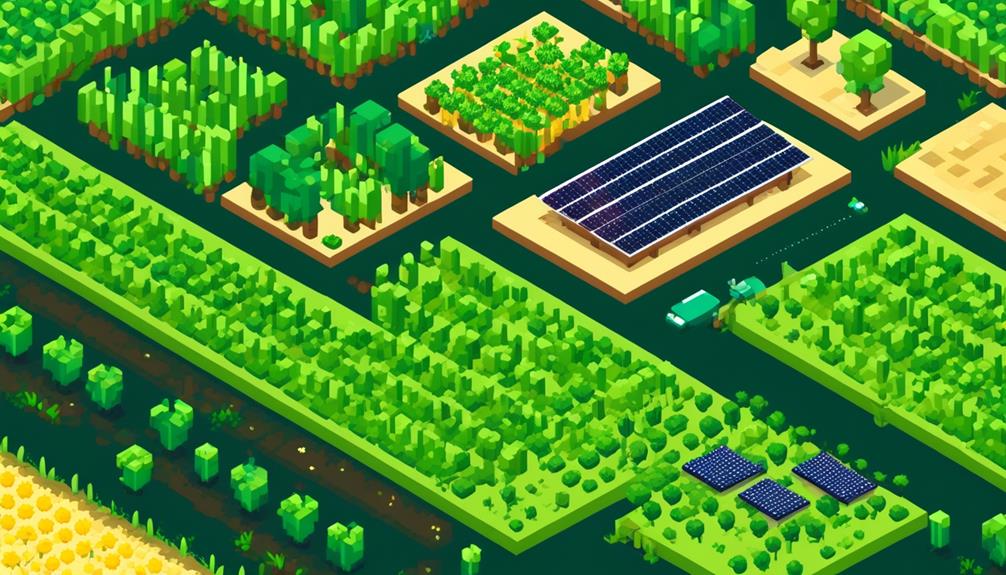
Sensors and monitoring systems play a crucial role in smart agriculture, collecting essential environmental and machine metrics to aid farmers in making informed decisions. In the realm of IoT in agriculture, these sensors are specifically designed for the farming industry, enabling precision farming practices and enhancing overall agricultural efficiency.
The use of smart sensors in agriculture has revolutionized the way farmers monitor and manage their fields. These sensors are capable of monitoring various factors such as soil moisture, temperature, humidity, and light intensity. By collecting real-time data, farmers can make informed decisions about irrigation, fertilization, and pest control, optimizing crop yields while minimizing resource waste. These sensors can also be integrated with automated irrigation systems, allowing farmers to remotely control water flow based on real-time data.
In addition to environmental monitoring, sensors are also used for machine metrics. For example, sensors can be installed on farming machinery such as tractors and harvesters to monitor fuel consumption, engine performance, and operating conditions. This data can help farmers schedule maintenance, reduce downtime, and optimize machine usage.
Furthermore, IoT sensors aid in monitoring climate conditions, greenhouse automation, crop management, and cattle monitoring. They enable farmers to remotely monitor and control environmental factors within greenhouses, ensuring optimal growing conditions. Agricultural drones equipped with IoT technology are used for tasks such as planting crops, fighting pests, and crop monitoring. These drones are equipped with sensors that collect data on crop health, nutrient deficiencies, and pest infestations.
Automated Irrigation and Water Management
Automated irrigation and water management solutions in smart agriculture utilize IoT technology to remotely control irrigation pumps and optimize water usage based on real-time data collected from soil sensors, weather stations, and meteorological satellites. These IoT agriculture sensors help farmers monitor soil moisture levels, weather conditions, and other relevant parameters to ensure precise and efficient water management. By integrating smart sensors with irrigation systems, farmers can automate the irrigation process and adjust water application based on the specific needs of different crops, resulting in improved water usage efficiency and increased crop yield.
To illustrate the benefits of automated irrigation and water management solutions, the following table showcases some key features and advantages:
| Features | Advantages |
|---|---|
| Remote control | Enables farmers to monitor and control irrigation systems from anywhere, reducing manual labor and saving time. |
| Real-time data | Provides accurate and up-to-date information on soil moisture levels, allowing farmers to make data-driven decisions regarding irrigation scheduling. |
| Water optimization | Optimizes water usage by delivering the right amount of water at the right time, minimizing water waste and reducing costs. |
| Crop-specific settings | Allows farmers to customize irrigation settings based on the specific water requirements of different crops, ensuring optimal growth conditions. |
| Integration with weather forecasts | Utilizes weather data to adjust irrigation schedules and avoid overwatering or irrigation during rainfall, further enhancing water efficiency. |
Automated irrigation and water management solutions play a crucial role in Precision Agriculture, enabling farmers to achieve higher productivity while conserving water resources. By harnessing the power of IoT technology and smart sensors, these agriculture solutions contribute to sustainable farming practices and help address the challenges of water scarcity in the agricultural sector.
Livestock Tracking and Management
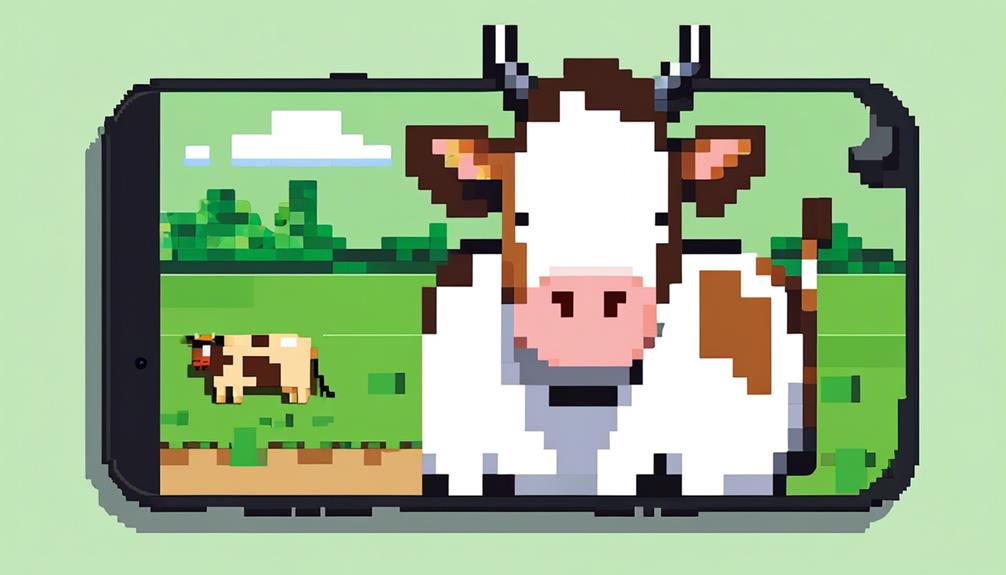
Livestock tracking and management is a crucial aspect of IoT in agriculture.
Through the use of IoT sensors, farmers can monitor the health of their animals and analyze their grazing behavior.
This data enables them to make informed decisions about the well-being and productivity of their livestock, ultimately leading to more efficient and sustainable farming practices.
Animal Health Monitoring
Animal health monitoring plays a crucial role in the successful tracking and management of livestock, utilizing IoT solutions to ensure optimal performance and well-being. Farmers can rely on IoT devices and sensors to monitor the health and reproduction of their livestock in real-time.
Here are three ways in which animal health monitoring enhances livestock tracking and management:
- Tracking Livestock Behavior: IoT sensors enable farmers to monitor animal behavior and detect any abnormal patterns or signs of illness. This early detection allows for prompt intervention, preventing the spread of diseases and ensuring the overall health of the herd.
- Environmental Monitoring: IoT devices can measure and analyze environmental conditions such as temperature, humidity, and air quality. By monitoring these factors, farmers can create an optimal living environment for their livestock, minimizing stress and improving their well-being.
- Preventing Theft and Containment Issues: Livestock tracking and management systems powered by IoT help farmers secure their livestock and prevent theft or containment issues. Real-time tracking and alerts enable swift action, ensuring the safety and security of the animals.
Grazing Behavior Analysis
Grazing behavior analysis plays a pivotal role in livestock tracking and management, providing valuable insights into the preferred grazing patterns and duration spent in different areas by utilizing IoT sensors to monitor the movement of animals within grazing areas. This smart use of sensors and IoT solutions allows farmers to collect data on the grazing behavior of their livestock, enabling them to make informed decisions about pasture management and rotational grazing practices. By understanding the impact of grazing on land and vegetation, farmers can optimize their pasture management strategies. Additionally, grazing behavior analysis aids in tracking the health and reproduction status of livestock, ensuring early detection of illnesses and efficient breeding management. It also helps prevent livestock theft and ensures their containment within designated areas.
| Benefits of Grazing Behavior Analysis | Why It Matters |
|---|---|
| Provides insights on preferred grazing patterns | Optimizes pasture management |
| Monitors duration spent in different areas | Aids in tracking animal health |
| Enhances rotational grazing practices | Prevents livestock theft |
Smart Farming Equipment and Machinery
Smart farming equipment and machinery in the context of IoT in agriculture includes:
- Automated irrigation systems: These systems use IoT technology to remotely control and monitor water usage, optimizing irrigation processes.
- Precision livestock monitoring: This involves using IoT-enabled devices to track and manage livestock health and productivity.
- Remote farm equipment control: This allows farmers to remotely monitor and control machinery for improved efficiency and productivity.
These advancements in smart farming equipment and machinery contribute to increased automation and precision in agricultural practices.
Automated Irrigation Systems
Automated irrigation systems, a crucial component of smart farming equipment and machinery, revolutionize the irrigation process by utilizing IoT technology to optimize water usage and crop management. These systems offer numerous benefits in the field of agriculture.
Here are three key advantages of automated irrigation systems:
- Improved water efficiency: With smart agriculture sensors and IoT solutions, farmers can collect real-time data on soil moisture levels, weather conditions, and crop water requirements. This data allows for precise and efficient irrigation, reducing water wastage and ensuring optimal hydration for crops.
- Enhanced crop management: Automated irrigation systems enable farmers to remotely monitor and control irrigation pumps, fertilizers, and pesticides. This automation streamlines the application process, reducing manual labor and enhancing overall crop management efficiency.
- Real-time monitoring: IoT sensors integrated into automated irrigation systems provide farmers with real-time information on environmental conditions, such as temperature, humidity, and light levels. This data allows for proactive decision-making, ensuring crops receive the ideal conditions for growth.
Precision Livestock Monitoring
The expansion of IoT technology in agriculture extends beyond automated irrigation systems to encompass precision livestock monitoring, a critical component of smart farming equipment and machinery.
Precision livestock monitoring tools leverage IoT sensors to remotely control irrigation pumps, collect soil and weather data, and automate processes for increased productivity. These solutions enable farmers to track and manage the health and reproduction of animals, ensuring optimal conditions for their livestock.
By incorporating IoT devices, farmers can also enhance security measures, effectively containing and preventing theft. Additionally, IoT solutions in precision livestock monitoring enable automatic application of fertilizers and pesticides, streamlining the farming process for efficient crop growth.
Furthermore, greenhouse management is improved with IoT technology, allowing farmers to monitor and control greenhouse conditions effectively. Overall, precision livestock monitoring plays a vital role in farm management by leveraging IoT technology to optimize productivity and ensure the well-being of both livestock and crops.
Remote Farm Equipment Control
With the integration of IoT technology, remote farm equipment control has revolutionized the way farmers manage and operate their smart farming equipment and machinery. This advancement in agriculture technology has brought numerous benefits to farmers, including increased efficiency, improved productivity, and reduced labor costs. Here are three ways remote farm equipment control is transforming the agricultural industry:
- Improved irrigation management: IoT solutions like Nano Ganesh allow farmers to remotely control irrigation pumps using their mobile phones. This enables them to efficiently manage water usage, monitor soil moisture levels, and ensure optimal irrigation for their crops.
- Automated fertilization and pesticide application: IoT technology automates the application of fertilizers and pesticides, ensuring precise and timely distribution. This not only reduces wastage but also minimizes the environmental impact of excessive chemical usage.
- Greenhouse management: IoT solutions enable real-time monitoring and control of greenhouse conditions. Farmers can remotely adjust temperature, humidity, and ventilation, ensuring optimal growing conditions for their crops.
Precision Agriculture Technology
Precision agriculture technology encompasses a range of innovative solutions for optimizing crop management, livestock monitoring, and mechanization access services in the agricultural industry. These technologies utilize IoT sensors and devices to track and collect information, allowing farmers to make data-driven decisions and improve productivity.
One of the key aspects of precision agriculture is the ability to monitor and analyze weather conditions in real-time. By collecting data on temperature, humidity, rainfall, and wind speed, farmers can adjust their irrigation and fertilization practices accordingly, maximizing crop yield while minimizing resource waste.
In addition to crop management, precision agriculture technology also includes smart livestock monitoring tools. IoT sensors can be used to track the health and behavior of livestock, allowing farmers to detect any signs of illness or distress early on. This enables timely intervention and improves overall animal welfare. Furthermore, IoT-enabled devices can automate tasks such as feeding and milking, reducing labor requirements and improving efficiency on dairy farms.
Another aspect of precision agriculture is mechanization access services. IoT-based solutions provide farmers with access to tractor services and agricultural equipment through booking systems. This not only saves farmers time and effort in searching for available machinery but also optimizes the usage and profitability for equipment owners. By integrating rugged devices, GPS technology, and international SIM cards, farmers can conveniently book and track the location of agricultural equipment, ensuring timely and efficient operations.
Connected Greenhouse Solutions
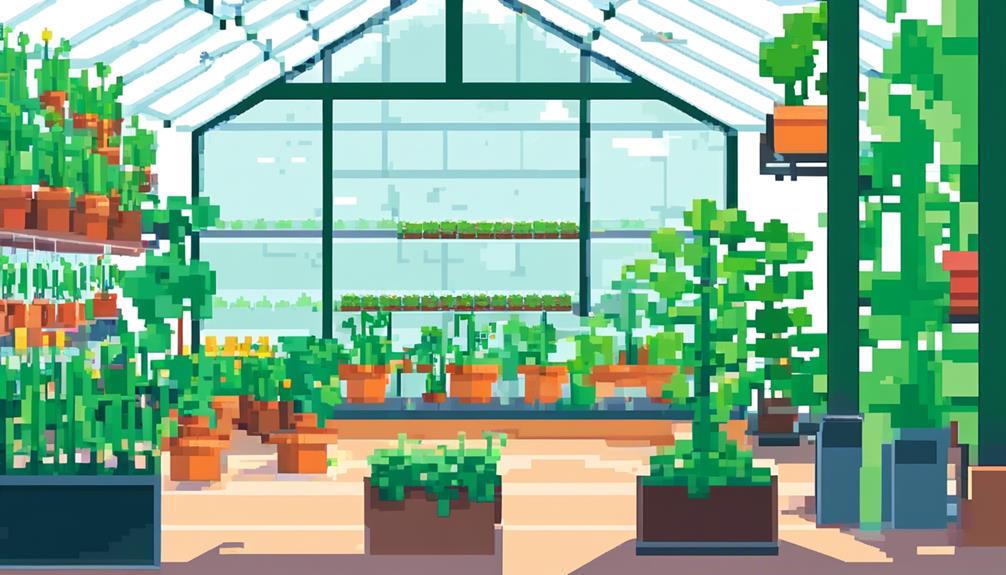
Connected greenhouse solutions leverage IoT technology to optimize crop management and enhance productivity in controlled agricultural environments. By using IoT sensors, farmers are able to track and monitor various aspects of their greenhouse operations, allowing for more precise and efficient management.
Here are three key ways in which connected greenhouse solutions are helping farmers:
- Automated Control: IoT technology enables automated control of greenhouse systems such as temperature, humidity, and irrigation. Connected sensors continuously monitor these parameters and adjust them as needed, ensuring optimal growing conditions for crops. This not only reduces manual labor and human error but also helps farmers maximize crop yield and quality.
- Weather Monitoring: Connected greenhouse solutions integrate weather stations to gather real-time data on temperature, humidity, rainfall, and other weather conditions. This information is then analyzed using analytics tools to provide insights and predictions. By understanding how weather patterns impact crop growth, farmers can make informed decisions about irrigation, ventilation, and other greenhouse operations.
- Crop Monitoring: IoT sensors are used to track and monitor crop health and growth parameters such as soil moisture, nutrient levels, and light intensity. This data is collected and analyzed, allowing farmers to identify potential issues early on and take immediate corrective actions. By closely monitoring crops, farmers can optimize resource allocation, prevent diseases, and ensure optimal growth conditions.
Soil and Crop Monitoring Devices
Soil and crop monitoring devices play a crucial role in providing real-time data on soil quality and crop growth, allowing farmers to make informed decisions and optimize their farming practices. These IoT-based smart devices collect data on environmental conditions such as temperature, humidity, and soil moisture levels. By continuously monitoring these parameters, farmers can gain actionable insights into their crops' health and growth patterns, enabling them to take proactive measures to improve production and reduce waste.
One of the key benefits of soil and crop monitoring devices is their ability to detect anomalies in crop growth. By tracking factors such as plant height, leaf color, and growth rate, farmers can identify early signs of diseases or infestations. This early detection allows for timely interventions, preventing the spread of the problem and minimizing crop losses.
To further enhance precision farming techniques, soil and crop monitoring devices offer real-time information on soil conditions. Farmers can monitor soil moisture levels, pH levels, and nutrient content, ensuring optimal conditions for plant growth. With this data, they can make informed decisions about irrigation, fertilization, and other farming practices, leading to improved crop yields.
Two examples of soil and crop monitoring devices are Arable and Semios. Arable's Mark device measures microclimate factors such as temperature and humidity, while also capturing plant-level data like leaf wetness and canopy cover. It provides farmers with comprehensive insights into their crops' health and growth.
Semios, on the other hand, focuses on pest management. Its devices monitor insect populations, weather conditions, and other variables to help farmers make informed decisions about pest control strategies.
Data Analytics and Decision Support Systems
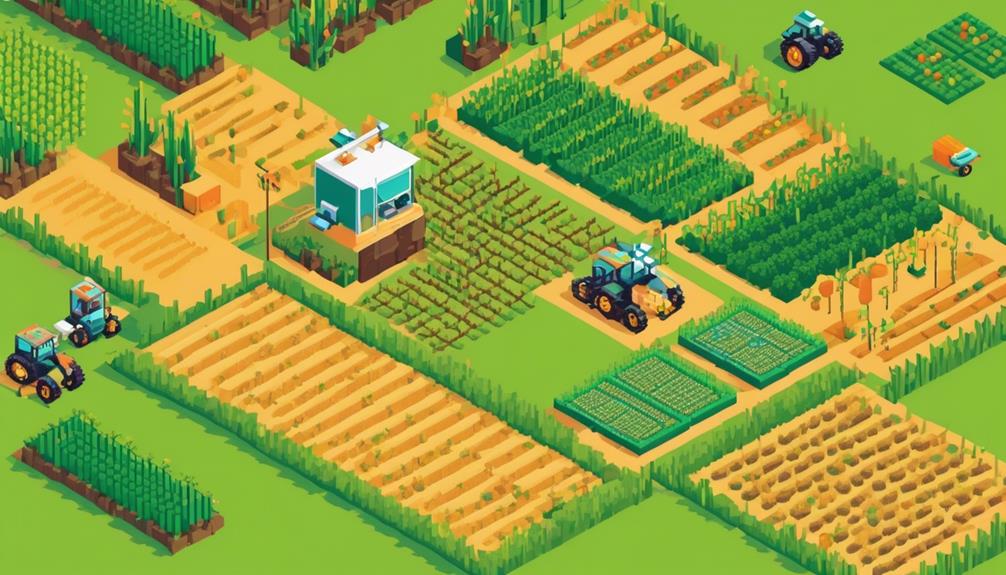
Data analytics and decision support systems in agriculture play a pivotal role in optimizing farming operations by analyzing data collected from IoT sensors. These systems provide farmers with valuable insights and enable them to make informed decisions that can have a significant impact on their productivity and profitability.
Here are three key ways in which data analytics and decision support systems benefit farmers:
- Time Management: By automating data collection and analysis, these systems save farmers valuable time that can be better utilized in other critical tasks. Instead of manually collecting and analyzing data, farmers can rely on these systems to provide them with real-time insights, allowing them to focus on other aspects of farm management.
- Supply Chain Management: Data analytics and decision support systems help farmers in optimizing their supply chain processes. By analyzing data related to weather conditions, soil conditions, and crop metrics, these systems provide farmers with accurate information about crop yields and quality. This enables farmers to plan their harvest and distribution schedules more effectively, reducing waste and improving overall supply chain efficiency.
- Pesticide Use Management: These systems also contribute to the effective management of pesticide use. By analyzing data from IoT sensors, farmers can monitor pest activity levels and identify areas that require targeted intervention. This helps in reducing the overall use of pesticides, minimizing environmental impact, and ensuring the safety and quality of the produce.
Frequently Asked Questions
How Can Iot Be Used in Agriculture?
IoT can revolutionize the agriculture industry by enabling various applications. Crop monitoring, soil and water management, and livestock tracking are some of the key areas where IoT can bring significant advancements. With the help of IoT sensors and data analytics, farmers can gather real-time information on crop health, soil moisture levels, and weather conditions. This enables timely interventions, such as adjusting irrigation and applying pesticides, resulting in improved crop yields and resource efficiency. Additionally, livestock tracking systems can enhance productivity and animal welfare by monitoring health, reproduction, and feeding patterns. Overall, IoT technology has the potential to greatly benefit the agriculture industry by providing actionable insights and improving decision-making processes.
What Are the Major Components of Iot Based Smart Farming?
The major components of IoT-based smart farming encompass sensor integration, data analytics, remote monitoring, precision farming, crop health monitoring, irrigation management, and livestock tracking.
These elements collectively enable farmers to optimize their agricultural practices through real-time monitoring, analysis, and decision-making.
Sensor integration allows for the collection of data on various parameters such as soil moisture, temperature, and crop growth.
Data analytics helps in deriving meaningful insights from the collected data, while remote monitoring enables farmers to monitor and control their agricultural operations from a distance.
Precision farming techniques ensure targeted and efficient resource utilization, while crop health monitoring and irrigation management aid in maintaining optimal crop conditions.
Lastly, livestock tracking facilitates better management and health monitoring of livestock.
Which of the Following Is an Example of an Iot Application in Agriculture?
An example of an IoT application in agriculture is the use of precision agriculture techniques. These techniques incorporate crop monitoring, livestock tracking, soil moisture management, automated irrigation systems, pest and disease detection, and climate and weather monitoring.
What Device Is Used for Smart Farming?
Sensor technology is a crucial component in smart farming, enabling precision agriculture and efficient crop monitoring.
One device commonly used for smart farming is the IoT sensor, which collects data on various agricultural parameters such as soil moisture, temperature, and humidity. This data is then used to automate irrigation, manage soil moisture levels, and remotely monitor and control farming operations.
Additionally, sensor technology allows for livestock tracking, ensuring optimal management and health of the animals.
